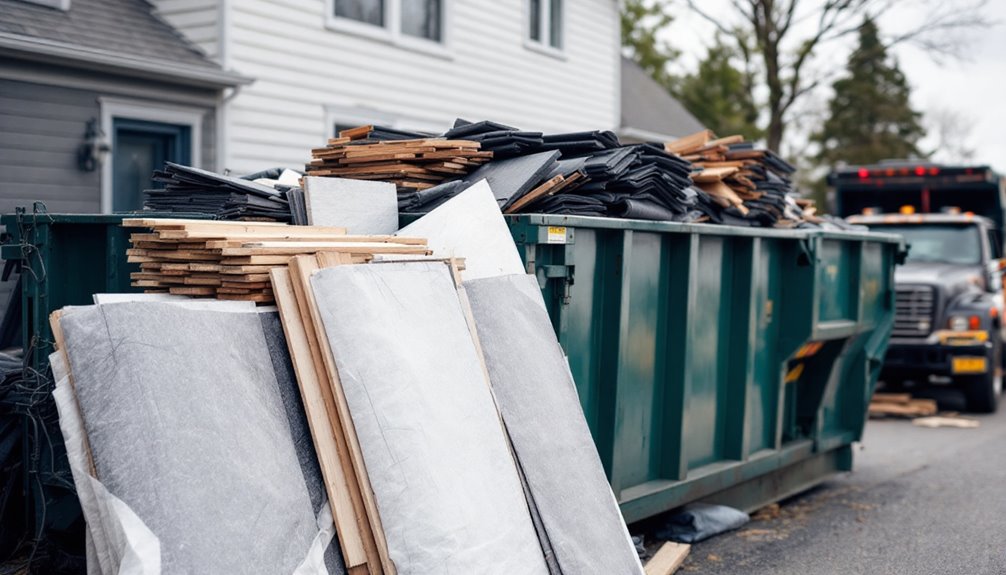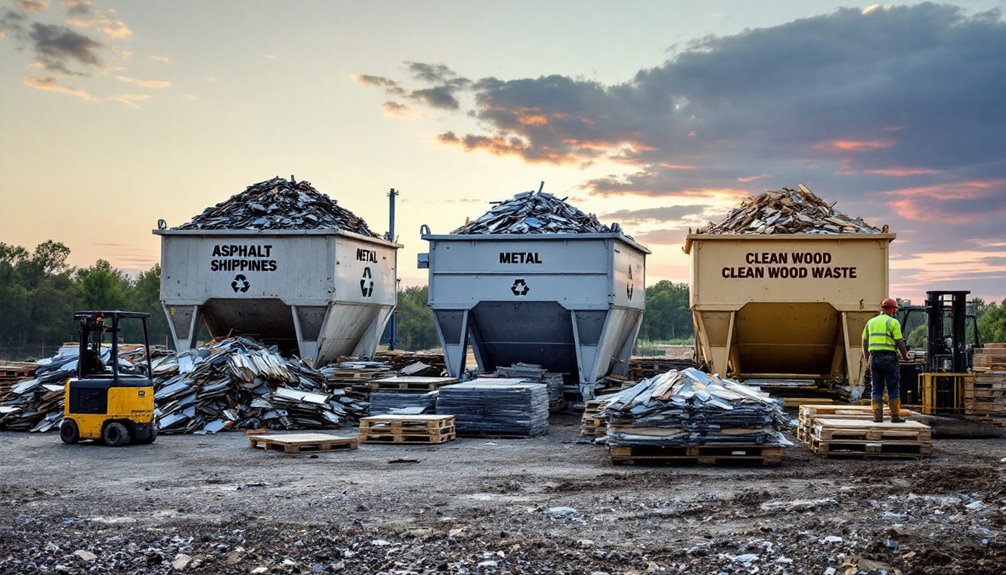To dispose of roofing materials properly, you’ll need to sort them by type first. Asphalt shingles can go to specialized recycling facilities where they’re transformed into pavement materials. Metal roofing is 100% recyclable and should be taken to scrap yards. For specialty materials like EPDM or PVC, contact certified recycling facilities. Clay and concrete tiles can often be reused or recycled. Understanding your specific material type will help you choose the most sustainable disposal method.
Key Takeaways
- Contact local recycling facilities that accept roofing materials, as many offer specialized programs for asphalt shingles and metals.
- Rent a 30 cubic yard dumpster for large roofing projects to ensure proper containment and efficient disposal.
- Separate different roofing materials by type during removal to facilitate recycling and maximize material recovery.
- Return specialty materials like EPDM and PVC to manufacturers or certified recycling facilities for proper processing.
- Consider donating reusable materials like tiles and metal panels to construction salvage organizations or habitat restoration projects.
Understanding Different Roofing Material Types and Their Disposal Methods
Four main types of roofing materials require different disposal approaches: asphalt shingles, metal roofing, flat and specialty materials, and tiles.
While asphalt shingles take centuries to decompose, you can recycle them into pavement and new shingles through specialized screening processes. Professional recycling facilities use dual-vibratory screening to separate recyclable materials effectively.
Metal roofing offers the most sustainable option, as you’ll find it’s 100% recyclable and can be transformed into various products while using minimal energy. A 30 cubic yard dumpster provides ideal capacity for major roofing projects and complete tear-offs.
For flat and specialty materials like EPDM and PVC, you’ll need to send them back to factories for proper recycling.
Tile materials, including clay, concrete, and slate, present unique challenges due to their weight and bulk. You’ll want to prioritize reuse or recycling of tiles whenever possible to prevent overcrowding landfills.
Effective Shingle Recycling Strategies for Homeowners
Homeowners can kick off their shingle recycling efforts by partnering with local recycling facilities that specialize in processing roofing materials. You’ll be joining a community of environmentally conscious individuals who are making a difference in reducing landfill waste and conserving natural resources.
Here’s how you can effectively recycle your shingles:
- Contact certified recycling facilities in your area that accept asphalt shingles and verify their requirements
- Separate your roofing materials, removing non-recyclable items like nails, wood, and metal flashings
- Schedule pickup with a recycling-friendly waste hauler who’ll guarantee proper material handling
- Request documentation of proper recycling for potential tax benefits or green building credits
Remember that recycling works best in cooler weather when asphalt is more brittle, making the grinding process more efficient and cost-effective.
Professional Services for Roofing Waste Management

While recycling your roofing materials is an excellent first step, partnering with professional waste management services can take your environmental efforts to the next level. You’ll benefit from their specialized equipment, deep knowledge of local regulations, and commitment to eco-friendly practices.
When choosing a service provider, you’ll want to verify their licensing and check their track record for reliability. Look for companies that offer flexible rental periods and demonstrate a strong commitment to sustainability through recycling initiatives. These professionals will efficiently sort materials, provide appropriate containers, and guarantee proper disposal methods that comply with local guidelines.
You’ll also appreciate the streamlined construction process and potential cost savings through municipal recycling incentives, all while knowing you’re contributing to a cleaner environment.
Best Practices for Safe Handling and Transportation
Safe handling of roofing materials requires proper equipment, clear protocols, and careful attention to detail. When you’re working with roofing materials, it’s crucial to use appropriate equipment like ladder lifts, forklifts, and carts to minimize physical strain. You’ll want to make certain your work area and transport routes are free from obstacles before beginning any material movement.
- Always wear proper safety gear, including well-fitting gloves and safety harnesses
- Don’t exceed maximum weight limits when lifting, and ask team members for help with heavy items
- Secure all materials properly during transport using tarps and appropriate tie-downs
- Use specialized trailers for larger items and guarantee proper load distribution
Remember to keep your back straight and bend at the knees when lifting. If you’re unsure about handling certain materials, don’t hesitate to seek professional assistance.
Environmental Impact and Sustainable Disposal Options

Three major concerns drive the need for sustainable roofing disposal: environmental protection, legal compliance, and resource conservation. When you dispose of roofing materials responsibly, you’ll protect our shared environment while avoiding hefty fines and penalties.
| Impact Type | What You Can Do |
|---|---|
| Landfill Waste | Choose recycling facilities over landfills |
| Air & Water Quality | Partner with certified disposal services |
| Resource Depletion | Support shingle recycling programs |
You’ve got several eco-friendly options at your disposal. Consider recycling asphalt shingles for road construction, repurposing clay tiles for landscaping, or sending metal materials to recycling centers. By working with local recycling facilities and choosing sustainable disposal methods, you’ll join a community of responsible contractors and homeowners committed to environmental stewardship.
Frequently Asked Questions
How Long Does It Take for Roofing Materials to Decompose in Landfills?
You’ll find that roofing materials, especially asphalt-based ones, don’t actually decompose in landfills. They can remain intact for hundreds of years, breaking down physically rather than biodegrading.
Can I Mix Different Types of Shingles in the Same Recycling Load?
You shouldn’t mix different shingle types in one recycling load. Most facilities require separate loads for each material type to guarantee proper processing and avoid contamination or rejection.
What Percentage of Roofing Material Costs Can Be Recovered Through Recycling?
You’ll typically recover 15-30% of your material costs through recycling, with metal roofing offering higher returns since you can recycle 100% of it and it retains significant value.
Are There Tax Incentives Available for Recycling Roofing Materials?
You’ll find federal tax credits for metal roofs (10%) and state-specific incentives, like Iowa’s sales tax exemptions and Idaho’s 20% equipment credit, plus LEED certification benefits for recycling roofing materials.
How Many Square Feet of Shingles Typically Fit in a Standard Dumpster?
You’ll find a standard 10-yard dumpster holds about 2,000 square feet of shingles, while a 20-yard dumpster can handle up to 5,000 square feet of your roofing material.
Conclusion
You’ve got several options for disposing of roofing materials responsibly. From recycling shingles at local facilities to hiring professional waste management services, you’re able to minimize environmental impact while following local regulations. Don’t forget to separate materials when possible and contact your local waste authority for specific guidelines. By choosing sustainable disposal methods, you’re helping reduce landfill waste and protect the environment.